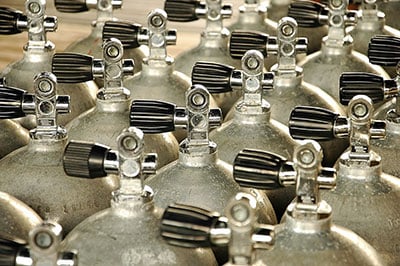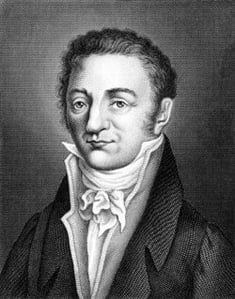Air Compressor Theory – The Cool Science Behind Compressed Air
Air is freely available everywhere in the world. But compressed air is not. So, what is compressed air, and what happens to air when it is compressed?
Read on to learn about the thermodynamics and physics of compressing air. We’ll also talk about the reasons for compressing air polytropically instead of isothermally or adiabatically (and don’t worry, we’ll explain those terms too.)
Introduction

Air - it's everywhere, and it’s essential for life as we know it. Every living being, from humans to animals to plants, relies on air to survive. But did you know that air is just as crucial for the machines and engines that power our world?
While we breath in air for oxygen, mobile services, factories, and production plants rely on air that is a little bit different, its compressed.
Compressed air is s compressed and then used as an energy source. Compressed air is an underrecognized power source that can energize tools, machines, and engines—and it does this quite efficiently!
In this article, we’ll explore the fascinating science behind compressed air and the key laws that make it such a vital energy source.
What Does “Compressed Air” Mean?
 Atmospheric air, which is the air that constantly surrounds us, is made up of many molecules and gas components. The composition looks something like this:
Atmospheric air, which is the air that constantly surrounds us, is made up of many molecules and gas components. The composition looks something like this:
- 78% Nitrogen molecules
- 20-21% Oxygen molecules
- 1-2% water vapor, carbon dioxide & other gas molecules
As gases, these molecules naturally space themselves out, filling up the volume available in free space.
When we compress air, we force those molecules closer together. The same molecules are in the air but occupy less space (volume) than when the molecules are free. Forcing these gas molecules together has some incredible consequences:
As the number of molecules increases in a given volume, the mass of air also increases. As that mass of air increases, its density also increases. And as the density increases, the pressure of air increases, and voila! We have compressed air.
Basic Theory of Compressing Air
The air we breathe has two major components: nitrogen and oxygen.
Even though air is not a “perfect” or pure gas, the presence of nitrogen and oxygen in major proportion makes it conform very closely to a “perfect” gas. Perfect gases are known to obey a couple of laws:
- Boyle’s Law (PV = k)
- Charles’ Law (V/T = k)
Where:
P = Pressure
V = Volume
T = Temperature
k = constant
Together, Boyle’s law and Charles’ law form a combination law, represented as:
- PV/T = k
Okay, so what does all this mean?
The combination law can be understood better when we first break down Boyle’s and Charles’ Laws.
Understanding Boyle’s Law: PV = k

Robert Boyle
Boyle’s Law was created by Robert Boyle, a physicist and chemist, in 1662. The law has stood the test of time and explains the relationship between pressure and volume.
PV = k means that pressure (“P”) multiplied by volume (“V”) will always equal a constant (“k”). If the volume decreases, you’ll need more pressure to meet the same constant as before (and vice versa).
Boyle’s Law tells us this: as the volume of the space containing air reduces, the pressure increases if the temperature stays the same. That means we can increase the pressure of air by forcing it into a smaller space.
Breaking Down Charles’ Law: V/T = k

Joseph Louis Gay-Lussac
Now, let’s add Charles’ Law, which uses the V/T = k formula.
Charles’ Law, also called the “law of volumes,” tells us what happens to a gas when it’s heated or compressed.
Charles’ Law is a bit newer than Boyle’s Law but is still quite old. Jacques Charles figured out the relationship between volume and temperature in the 1780s, and Joseph Louis Gay-Lussac first published the discovery in 1802. (Joseph gave Jacques full credit and decided to name the law after Jacques, which was pretty cool of him.)
Anyway, Charles’ Law tells us that a gas’ volume (“V”) divided by its temperature (“T”) equals a constant (“k”), which is pressure. When you increase temperature, you also proportionally increase volume to maintain the same pressure.
That’s because the molecules in the gas move away from one another as they are heated, increasing the amount of space the gas takes up.
Putting Boyle’s & Charles’ Laws Together
But what happens when you decrease the volume and force those molecules closer together than they want to be? Hello, combination law!
Boyle’s Law helps us understand pressure and volume, while Charles’ Law teaches us about volume and temperature. But pressure, volume, and temperature all come into play together with that combined formula we mentioned before:
- PV/T = k
Pressure (“P”) multiplied by volume (“V”) divided by temperature (“T”) equals a constant (“k”).
The combination law explains what happens to air when it’s compressed into a smaller volume. It tells us that when air is compressed, the air’s pressure and temperature increase as the volume of the space containing air decreases.
By pushing air into a smaller space, we force it to become hotter and more pressurized. The molecules within the air will try to spread apart, returning to their natural distance, and it’s this constant attempt to move away from one another that causes pressure.
Theoretical Compression Types
Now that we understand what happens to air when it's compressed, let's talk about how we compress it. Theoretically, air is compressed in two ways:
- Isothermal compression
- Adiabatic compression
Isothermal compression
Isothermal compression may sound intimidating, but it’s straightforward, starting with its name. “Iso” means “equal” or “same,” and “thermal” means “heat,” so we’re just talking about a form of compression where heat stays the same.
Isothermal compression is the process of compressing air without changing the existing temperature of the system. Now that you’re familiar with combined law, you’re probably thinking, “But wait! How can we possibly increase pressure without increasing the temperature?!”
The answer: You can’t! It’s the Law. But that doesn’t mean you must keep the increased temperature after the air is already compressed.
With isothermal compression, the heat produced during compression is removed at the same rate it’s created to keep the temperature constant. In theory, the compressor must be designed so that heat generated can also be extracted at an equal rate.
If you’ve been paying attention, you may be thinking that this sounds familiar. Good job! Isothermal compression is represented by the same formula as Boyle’s Law: PV = k.
However, isothermal compression presents real-world limitations: the air needs to be compressed more slowly, the cylinder bore must be small, and the system requires a high standard of cooling. This means the entire system needs to slow down and become a lot less efficient. Boo.
Adiabatic Compression
Adiabatic compression, also known as isentropic compression, is the opposite of isothermal compression. With adiabatic compression, the heat generated by compressing air is not removed from the system. Instead, all the heat generated during the act of compression stays in the compressed air.
Theoretically, the adiabatic compression process is represented as PV^γ = k, or volume to the power of gamma (“V^γ”), multiplied by pressure (“P”), equals a constant (“k”). To learn more about how this is derived, check out this video from UNSW’s School of Physics:
While adiabatic compression is fine in theory, it also provides real-world limitations. Air that’s too hot is dangerous and can result in both system failure and safety issues. Therefore, extremely hot compressed air isn’t desirable for most applications.
Polytropic Compression
There are huge practical constraints in the isothermal and adiabatic theoretical compression processes. The real-world air compression process blends isothermal and adiabatic compression to overcome these constraints in a process called polytropic compression.
Remember, isothermal compression is the most desirable way to compress air, but it’s not possible. Even with the best cooling systems available, the physical components that compress air would need to slow down so much that the air delivery rate would be too slow for practical use. Therefore, we compromise and use the hybrid approach called polytropic compression.
Real-world air compression typically involves this mix of adiabatic and isothermal principles. The air heats up during compression (adiabatic), but cooling is applied to minimize temperature rise (closer to isothermal) without disrupting the flow of compressed air. This balance helps improve efficiency and performance.
The end-result is efficiently compressed, reasonably cooled air that’s ready to use!
